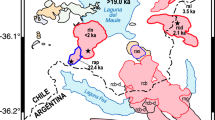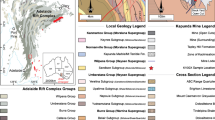Abstract
Epidote occurs in four textural varieties in the Mount Lowe intrusion of southern California: euhedra, anhedra, intergrowths and cross-cutting veins. Of these, conspicuous elongate euhedra, which range up to 3 cm in length, meet most of the established textural criteria for magmatic epidote. Equant anhedral grains, which are ˜5 mm in diameter, are texturally ambiguous although rare allanite cores are suggestive of a magmatic origin. Epidote intergrowths with hornblende and biotite also meet certain textural criteria for crystallization from a magma, notably, euhedral faces against biotite. Finally, late-stage veins of epidote cross-cut all phases in the rock and are likely subsolidus. Oxygen isotopic compositions of these four textural varieties of epidote determined using the laser probe indicate that the use of textural criteria alone in establishing epidote parageneses can be misleading. Intracrystalline δ18O variations in the euhedra document both magmatic and subsolidus compositions. Oxygen isotope compositions are bimodal averaging 5.36 ± 0.13‰ (n = 11) and 4.66 ± 0.23‰ (n = 21). These data combined with plagioclase and zircon δ18O values are interpreted to indicate that magmatic oxygen isotopic compositions have been preserved where epidote δ18O is greater than 5‰. Significant portions of each euhedral crystal have been affected by subsolidus exchange and are characterized by epidote δ18O values less than 5‰. Intracrystalline δ18O values of epidote anhedra range from 4.50 to 6.08‰ and thus also document both magmatic and subsolidus compositions. Subsolidus exchange is volumetrically less significant in the anhedra than in the euhedra. Values of δ18O for intergrowths and late-stage cross-cutting veins of epidote average 3.81 ± 0.22‰ and document clearly subsolidus growth. The data confirm that in the Mount Lowe intrusion, large euhedra of epidote are magmatic in origin, consistent with textural evidence. The data also indicate that equant anhedra of epidote are also magmatic in origin and thus the absence of good crystal faces does not necessarily indicate subsolidus growth. The subsolidus origin of intergrowths of epidote with euhedral faces against biotite indicates that well developed crystal faces do not require growth from a magma. Finally, the subsolidus origin of the vein epidote is consistent with textural evidence. The increased resolution available with laser-based oxygen isotope measurements offers an important test for documenting whether epidote is of magmatic or subsolidus origin. Given the barometric significance of magmatic epidote, oxygen isotope compositions can be used to aid in the interpretation of epidote-bearing plutons.
Similar content being viewed by others
Author information
Authors and Affiliations
Additional information
Received: 9 April 1996 / Accepted: 3 August 1996
Rights and permissions
About this article
Cite this article
Keane, S., Morrison, J. Distinguishing magmatic from subsolidus epidote: laser probe oxygen isotope compositions. Contrib Mineral Petrol 126, 265–274 (1997). https://doi.org/10.1007/s004100050249
Issue Date:
DOI: https://doi.org/10.1007/s004100050249




